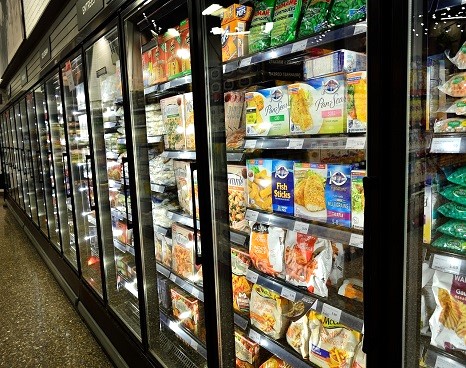The Role of Frozen Distribution in the UK’s Food Industry
 Frozen distribution is a major part of the UK’s food industry, providing ways to keep food safe and fresh no matter how far it has to go. The ability to freeze and distribute food helps extend product shelf life, maintain quality, and reach a broader audience across the nation, from frozen meals and meats to seafood, bakery items, and ice cream. In this post, we take a look at why frozen distribution is important and how it helps the food industry in general.
Frozen distribution is a major part of the UK’s food industry, providing ways to keep food safe and fresh no matter how far it has to go. The ability to freeze and distribute food helps extend product shelf life, maintain quality, and reach a broader audience across the nation, from frozen meals and meats to seafood, bakery items, and ice cream. In this post, we take a look at why frozen distribution is important and how it helps the food industry in general.
Ensuring Freshness and Quality Preservation
The capacity of frozen distribution to maintain food’s nutritional value and freshness is one of the main justifications for its use in the food sector. Food that is frozen when still fresh retains its flavours and nutrients, avoiding spoiling. Because preservatives are no longer necessary thanks to this procedure, consumers may savour foods that taste as fresh as they did when they were first created.
For example, frozen meals are becoming more and more popular as people look for quick and healthy meal options. Meal kits or pre-cooked meals can be supplied to households and supermarkets with the guarantee that they stay in top shape because of frozen distribution. People can now enjoy tasty, nutritious food without sacrificing convenience or quality thanks to this preservation technique.
Expanding Reach in the Frozen Meat Sector
Frozen distribution is important in the meat sector as it allows retailers and suppliers to extend to customers beyond local markets. Now, meat products can be transported over long distances safely without spoiling. Whether it’s beef, lamb, or poultry, freezing means that the meat is fresh from production to when it hits the shelf.
This allows retailers to stock a greater variety of meats in frozen form to meet consumer demand for both everyday cuts and specialty items. This extended reach is especially useful for smaller, independent suppliers that are looking to grow their operations beyond regional boundaries without fear of product loss.
Frozen Seafood: Preserving the Ocean’s Bounty
Although eating seafood is common in the UK, many types, including fish and shellfish, spoil quickly. Because frozen distribution keeps the catch fresh until it is consumed, it has completely changed the way seafood is sold and consumed. Freezing guarantees that seafood, whether it is quality shellfish or fresh fish fillets, keeps its flavor and texture for a long time after it is caught.
Suppliers can reach consumers across the country with frozen seafood, providing a greater range of fish and seafood to satisfy demand. Access to premium ocean goods has expanded thanks to frozen distribution, which has made it possible to supply seafood to markets located far from the shore.
The Frozen Bakery Sector: From Oven to Freezer
The bakery industry also depends heavily on frozen distribution, especially for companies that need to ship their goods over great distances. When they are at their freshest, cakes, bread, and pastries can be frozen, thawed, and cooked as needed. This method enables bakeries to reach a larger audience and generate enormous volumes of baked goods.
Supermarkets, cafes, and restaurants can offer freshly baked delicacies without the time-consuming preparation by using frozen bakery items. To guarantee that consumers receive hot, fresh goods without compromising quality, a bakery can, for instance, provide frozen croissants that can be swiftly baked on-site.
Ice Cream and Frozen Desserts: Keeping Cool and Sweet
The ice cream industry is among the most evident industries reaping the benefits of frozen distribution. Strict temperature control across the supply chain is essential for frozen desserts to preserve their consistency, flavour, and texture. Ice cream manufacturers can use frozen distribution to get their goods to stores and customers across the country while maintaining product quality and coldness from the production facility to the end user.
Furthermore, frozen distribution enables ice cream producers to provide a broad range of year-round options, such as seasonal and exotic flavours, in response to the growing demand for plant-based and dairy-free options.
The Environmental Impact of Frozen Distribution
There is an environmental impact of frozen distribution, both good and bad. Freezing decreases food waste by stopping products from being thrown out because they spoil. Transportation and food production are two of the biggest sources of carbon emissions, so reducing waste is a step towards sustainability.
However, freezing requires a lot of energy, especially when goods are being transported. Thankfully, the development of renewable energy sources and energy-efficient refrigeration is helping to reduce the environmental impact of frozen distribution and make it more sustainable over time.
Convenience for Consumers and Businesses
Frozen distribution offers unparalleled convenience for both consumers and businesses. The ability to buy a wide range of frozen foods gives consumers the opportunity to buy essentials and plan ahead, as well as reduce food waste. Frozen distribution helps businesses manage inventory and eliminates the need to restock frequently as frozen products have a longer shelf life than fresh goods.
A Key Element of the Food Industry
Frozen distribution is a vital part of the UK’s food industry, with significant advantages for food preservation, product range and logistical efficiency. It offers a way for businesses to meet consumer demand while maintaining product quality and safety for frozen meals and meats, ice cream and bakery products. Frozen distribution is a vital service to the businesses and consumers that rely on it, and this essential service will only become more important as the industry grows.